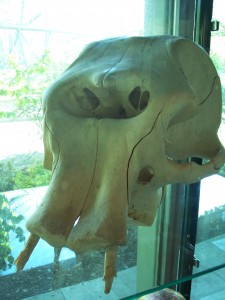As a word, myth has taken on negative connotations. False modern stories are dismissed as “urban myths”, myths are seen as old superstitions to be ‘busted’ by scientific truth. There are geologists who take a different view. Taking myth in its original sense – the stories by which pre-literate societies make sense of their world – they see it as a precious scientific resource, shedding light on dramatic but infrequent geological events that might otherwise go unrecognised.
Myths have traditionally been studied by those trained in ‘the arts’. They have been studied for their religious, or psychological or literary qualities. Looked at like this, they seem in opposition to a modern scientific world-view. At the most extreme, myths are either stories told by those ignorant of how the world really is, or insights into realities that transcend ‘reductive science’. Perhaps this tension between science and myth is not one that would make sense to the actual authors of the myths. They were intelligent and observant people trying to make sense of the world. They described events in terms of their world-view, (fighting gods and such-like) but that doesn’t mean they weren’t describing real events to the best of their abilities.
A glimpse of the ways in which pre-literate societies store practical information about geological events came with the 2004 Indian Ocean ‘Boxing Day’ tsunami. In some remote areas people survived because they climbed to high ground in advance of the tsunami hitting. They did so because they recognised the warning signs from their verbal folklore, which advised moving to high ground in such cases. Such an ability to transfer important information across generations is clearly valuable. Perhaps this is going on in some myths, stories preserved from other pre-literate societies?
The Geological Society 2007 special publication Myth and Geology is a selection of papers from scholars grappling with this very question. The opening essay contains my favourite example of mythology that is clearly linked to a natural event; the Klamath Indians from Oregon in the US have a myth concerning a fight between the chief of Below World and the chief of the Above World. They hurled rocks and flames at each other and darkness covered the land. The fight ended when the chief of Below World was forced back into his kingdom. The hole where this happens remains – we know it today as Crater Lake, the site of a major volcanic eruption 6500 years ago. Human artefacts are found in the ash layers of this eruption so we can be certain that this myth is a modified eye-witness account.
Myth and Geology is full of stories like this. I want to pull out three themes – fossils, faults and impacts, leaving much of the book unmentioned.
Fossils and Myth
Before science came along with its amazing tale of life’s billions of years of twists and turns, what stories did we tell ourselves about fossils? Finding colossal bones of unfamiliar creatures, we told stories about fighting giants. Adrienne Mayor describes place names across the world based on the fossils found there. Native Americans were well aware of dinosaur track-ways, for example. Agnesi, Di Patti and Truden take us to Sicily and describe how elephant skulls found there are likely the origin for the myth of cyclops: giants with a single eye in the middle of their forehead. Fossil echinoids are common in southern England. K. J. McNamara describe how they were know as fairy loaves or thunderstones and associated with magic. Today they can found in significant places in the walls of old churches.
Earthquakes and Myth
Major earthquakes are geologically common events all around the Pacific Rim and figure in the myths of that region. Ludwin & Smits compare traditions from pre-Columban cultures in Cascadia (close to Seattle, USA) with Japan. Their broad thesis is that even when expressed in symbolic language, myth and folklore describe geological events.
In both areas, earthquakes are explained in terms the movements of creatures of great power living underground. In Cascadia, stories are of struggles between a Thunderbird and a whale, in Japan – giant catfish. In North America, the folklore helps clarify recent seismic activity on the Seattle fault, and so sheds light on future hazards.
The Japanese material is from the 18th Century and is in the form of sophisticated pictures. My favourite has to be the one showing “courtesans and male workers of the elite brothel district” attacking a giant earthquake-causing catfish. A group of builders rushes in to defend the fish, as earthquakes bring them a lot of work.
A fairly well known piece of geomythology concerns the Delphic Oracle. Consulting oracles was a major political and cultural part of Ancient Greece, featuring frequently in Greek literature. The Oracle was consulted and then went into a special place to consult with the Gods, breathing vapours that arose from the ground. Recent geological work shows that the temple sits on a fault and that it is plausible that ethylene vapours were present. In a recent BBC Radio ‘In Our Time’ program on the Delphic Oracle this research was raised. An expert on Ancient Greece culture dismissed it in a word. She gave no reasons, perhaps showing the disdain towards science sadly so often found in British ‘Arts Graduates’.
Myth and cosmic impacts
I’ve talked so far about common, important but infrequent events. There is another set of events so uncommon that no-one living has witnessed one – major cosmic impacts, where a big chunk of space comes hurtling out of the sky. Massie & Massie write about a big dataset of myths from South America. They link myths that talk about ‘sky fall’ or ‘great darkness’ with Andean volcanic eruptions and associated ash clouds. Having established the usefulness of their data-set, they turn to another set of myths that talk of a ‘world fire’ with origins in the sky. They link a set around Argentina with a known impact site, Campo del Cielo. Other data, myths collected from the Brazilian Highlands and elsewhere can’t be linked to any obvious crater, but they speculate a link to an ‘air-burst’ where the impacting object doesn’t reach the ground, but does create enough energy to cause widespread burning.
This paper is only a part of the work Bruce Masse is doing. Looking at flood myths from around the world he proposes a link between them and a major cometary impact in the Indian Ocean. This would apparently put large volumes of water into the atmosphere, causing rain, plus massive flooding around the world.
Myth and belief
I’ve deliberately stuck to describing the work where the author is describing the myths of another culture. In these cases, the author has no emotional stake in the validity of the myth and they are objective. In the case of a Christians looking for Noah’s Ark, or the role of geological features in Hindu faith, I have my doubts that a person’s beliefs will not get in the way of a rational analysis of the facts </english understatement>.
One consequence of geomythology, this new way of looking at myths, is that it reduces the gap between us and humans in the distant past. To quote Myth and Geology it provides us “with a profound respect and appreciation for the observational powers of our ancestors”. A modern scientist describes natural phenomena in light of her world-view, no less than any myth-maker. With ‘science’ we have a fantastic, useful and sophisticated world-view that has been tested against reality for centuries. What a privilege! However, without the benefit of this body of knowledge and ways of thinking, are we modern people much different from our ‘primitive’ ancestors? After all, we all just want to make sense of the world, one story at a time.
Note, David Bressan has an excellent post on the whole Japanese catfish, earthquake thing, including pictures.


